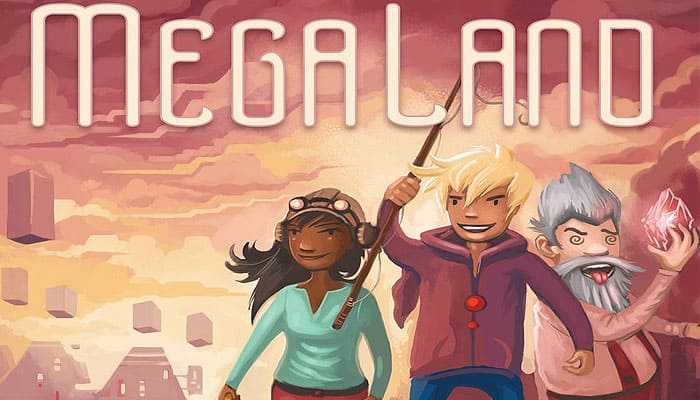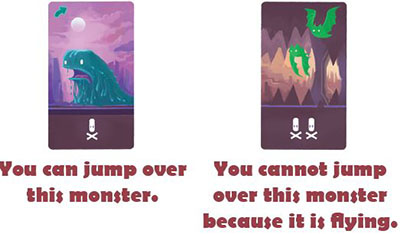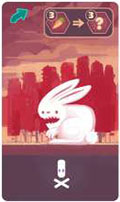
Components

- 10 Level Cards
- 5 Player Cards
- 96 Treasure Cards
- 1 Level Tile
- 8 Character Stands
- 14 Jump Tokens
- 32 Heart Tokens
- 39 Coin Tokens
- 1st Player Token
- 5 Character Tokens
- 1 Heart Cost Card
- 28 Star Building Cards
- 68 Building Cards
Each building card type can be stored in its own card slot in the game insert. Store the star cards near each other on one side of the insert, and the remaining cards on the other side of the insert.
Setup

1 Put all the star buildings in a row in the center of the play area, each type in its own pile, face up. You always play with all 6 types of star cards.
2 Choose seven (of the seven- teen) types of normal building cards and put them in a row under the star buildings, each type in its own pile, face up. If this is your first game, choose a set of buildings that has at least one of each cost (1-5).
Cost is in the upper-left corner of the card. Note: In future games, you don't always need to have one of each cost, but it's a good idea to have a wide spread of costs.
3 Shuffle the level cards and put them in a face-down pile. Then put the level tile next to the level deck.
4 Put the heart tokens, jump tokens, and coins next to the play area with the heart cost card nearby. This is the supply.
5 Shuffle the treasure cards and place them in a face- down pile.
6 Give each player a character and a player card. Give each player 4 heart tokens, which they place on the "heart" side of their card.
7 The player who played a video game most recently gets the first-player token.
Now you're ready to play!
Object of the Game
You come to Megaland, not for power-ups, but for coins! Search each new level for treasures to build a booming business back in Megaland City. Be careful, though. If you go too far, you'll lose it all! The game ends at 20 coins and the richest player wins!
Game Play
The game is played in rounds. Each round has three phases.
Phase 1: Run The Level
Are you ready to run? Send your character to the level by placing your character token on the level tile. Then draw a treasure card and put it above your player card. No need to take turns; in this phase all players place their characters and draw treasures simultaneously.
Once each player has placed their character token and drawn a treasure, the first player draws the top card of the level deck and puts it face up next to the level tile.

For each skull on the card, every player whose character is still on the level tile takes one damage! To take one damage, slide one heart token to the right side of your character card labeled "Injury".

 Treasure box |
Treasure Cards
Place all the treasures you collect in the level above your player card. You carry these with you in the level. When you return home, these treasures will be safe.
If you fall before returning home, they are discarded.
Treasure Box
When you draw the treasure box, everyone immediately draws 1 extra treasure.
When a Player "Falls"
If you have zero hearts left on the "heart" side of your player card after taking damage, you fall. Discard all the treasures above your player card and
 Taking a damage |
take your character off the level tile. (Any treasures taken home from previous runs are safe).
Next Level Card
After each level card is resolved, each player who hasn't fallen chooses whether to stay in the level or return home.
If You Stay in the Level
Leave your character on the level tile and draw 1 treasure. Once all players staying in the level have drawn a treasure, draw the next level card, take damage, etc. Repeat these steps until no players remain in the level.
If You Return Home
Take your character off the level tile. Take any treasures from above your player card and place them below the card; they are now safe. Then wait until all other players have returned home before moving to the next phase. You do not take dam- age or collect treasures after returning home.
Once all players have returned home, phase 1 ends.

Phase 2: Buy
Starting with the first player and moving clockwise, players take turns buying building cards from the center of the table with the treasures they own.

Buy a Building

On your turn, you may buy as many buildings as you can pay for. Each building costs a number of UNIQUE (different) treasure cards. The cost is listed in the upper left corner of the card.
Example: Tom buys a Lodge which costs 4. He pays 1 carrot, 1 stone, 1 crystal, and 1 egg. He may not pay 2 carrots and 2 stone, etc.
When you buy a building, discard the correct number of trea- sure cards and place the new building next to your player card to show that you own it. Some buildings give an immediate reward, and some give recurring abilities throughout the game.
Buy Hearts
On your turn, you can also buy extra hearts, as listed on the heart cost card.

To buy a heart, you must pay MATCHING goods. You start with 4 hearts. If you buy a 5th heart, it costs 2 matching goods. If you buy a 6th heart, it costs 3 matching goods, etc.
Example: Tom buys a 7th heart and pays 4 carrots.
When you pay treasures, place them in a discard pile, face up, next to the treasure deck draw pile. If the draw pile ever runs out, shuffle the discard pile to make a new draw pile.
After all players have had a turn to buy, phase 3 begins.
Important: You may only buy one of each building type per turn.
Example: You could not buy four "Sandwich Stand"s in one turn. But you could buy four if you bought only one each round.
Phase 3: Night
First Player

The first player passes the first-player token to the player on their left. This player is now the first player.
Discard or Store Treasures
You must discard all of your unused treasure cards each night. You may, however, keep one treasure per building you own (placing it under the building to show that the building is "storing it in the basement").
Moon Symbols
Any building abilities with a "moon" symbol now activate.
Example: Tom owns the Lodge. During phase 3, Tom gains 2 coins. Next round, on phase 3, Tom gains 2 coins again, etc.

Reset Hearts
Everyone resets their hearts. Slide any hearts on the injury (right) side of your player card to the heart (left) side, replenishing them for the next round.
Shuffle Level Deck
Pick up any drawn level cards and shuffle them back into the level deck. Every night this deck should return to ten cards, shuffled and face-down, ready for a new level.
End of the Game
At the end of the night phase, if any player has 20 coins, the game ends. Everyone counts their coins and whoever has the most coins is the winner! If no one has yet reached 20 coins, play returns to phase 1.
Building Cards
Check here to see all information about the Building cards.
Jump Tokens

Jump tokens can be used to avoid damage when you run a level. Before any level card is drawn, if you own a jump token, you can return it to the supply to declare that you are "jumping".
If the next level card has a jump symbol in the top left corner, you ignore all damage on the level card (1, 2, or 3)! If the card does not have a jump symbol, there is no effect (and you lose the jump token even though it has no effect).

Example: Mary declares that she will jump before the next level card is drawn. She returns a jump token to the supply. The card is the Sludge Monster, which would normally cause Mary to take 1 damage, but she ignores this damage
Trade with the Rabbit
When the rabbit card is drawn while you are running the level, you can feed carrots to the rabbit for new goods.
When you meet the rabbit, you may discard exactly 3 of your carrots to draw 3 new treasures from the deck. You still take a damage though. He bites before the trade! If you fall because of the rabbit, you cannot trade carrots.

This rabbit likes carrots, but only in sets of 3!
Continue Reading
